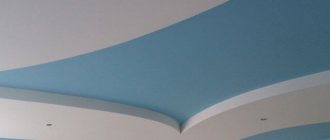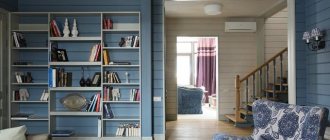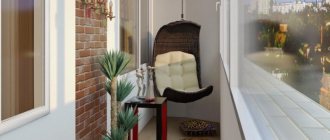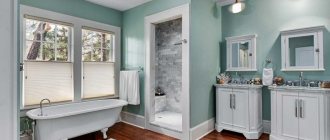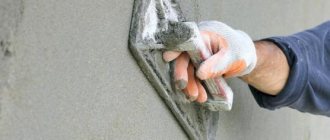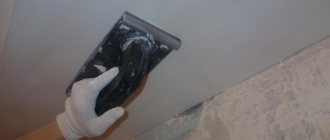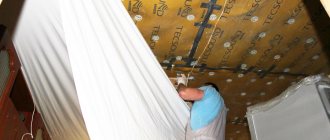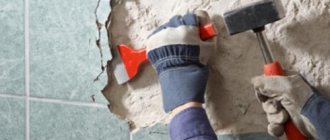Of the most common finishing options, water-based paint is especially popular. It has a lot of positive characteristics. It contains pigments, polymers, and water. The initial color of the finishing material is white, but by adding color it is possible to obtain the desired shade. In order for water-based ceiling paint to give maximum effect, you need to know how to choose it correctly and which manufacturers are leading in the market.
A high-quality painted surface creates the impression of coziness and comfort in the room.
Types of water-based paints for ceilings
Water-based ceiling paint is an environmentally friendly, hypoallergenic material that does not have a negative effect on the human body. After application to the surface, intensive evaporation of water from the material begins. The result is a smooth polymer coating with high moisture resistance. Read more about water-based paint here.
Which water-based paint to choose for the ceiling? The annotation for the paints will help you make a decision, where the manufacturer indicates:
- what types of work it is intended for;
- consumption per square meter;
- the ability to cover a dark background with color in the form of a white uniform canvas;
- abrasion resistance when wet cleaning
Before you start studying the annotation, you need to decide on the composition and texture of the paint, as well as for what purpose you will need it. Therefore, we suggest you understand the types of paints.
Types of ceiling paints by composition
The consumer market offers many types of water-based paints with various additives that are optimally suited for painting ceilings. This:
- acrylic;
- acrylic with latex added;
- based on polyvinyl acetate;
- silicone;
- with mineral composition.
Polyvinyl acetate are the cheapest. The disadvantage of such paints is that they cannot be used to decorate the ceiling in rooms with high humidity.
The most popular are acrylic, which are considered universal. They have increased abrasion resistance and fit well. When painted with water-based acrylic paint, the ceiling turns out perfectly smooth and beautiful.
The most expensive ones are acrylic with the addition of latex. They not only actively resist water, but are also able to mask shallow cracks. They can be used to paint the ceiling using old paint.
The advantage of silicone ceiling paint is that it “heals” cracks up to 2 mm thick. The painted surface, even without ideal preparation, turns out even and smooth.
Read more about the compositions and areas of application of various types of water-based paint in this article.
Types of paints by texture
There are matte, semi-matte and glossy paints.
Matte paint - better masks minor surface defects. For example, Tikkurila Euro White with microspheres scatters light, making the snow-white matte surface look flawless. It is ideal if there are small unevenness on the ceiling.
Glossy finishes are more resistant to abrasion and are easier to clean. Silky snow-white canvas visually increases the space of a small room. One of the most popular materials of this texture is Dufa paint from the Superweiss series.
glossy paint
matte paint
Types of paints by purpose
What paint is best to choose for the ceiling base in a children's room? A perfectly smooth matte ceiling is created with Dulux Magic White and Brite acrylic paints. They repel dust and other contaminants.
Semi-matte Tikkurila Luya and Dulux Diamond Soft Sheen effectively protect the ceiling of the kitchen and bathroom, where there is always high humidity, from condensation, and prevent the formation of mold and mildew.
Which water-based paint to choose for the ceiling of an office, hotel, restaurant? Use semi-matt Dulux Ultra Resist with added wax and silver ions. The wear-resistant coating is designed for rooms with high operating loads and moderate humidity; it can be used in medical and children's institutions.
Consumption per 1 m2 of wall
Consumption directly depends on the topography and porosity of the surface, absorption and preparation.
| Consumption 1 liter | m2 |
| Water-dispersed | 4m2 porous surface 8-12m2 flat |
| Latex | 4 m2 porous 12 m2 flat |
| Butter | 4 m2 porous 14 flat |
| Alkyd | 4 m2 porous 12 flat |
Table based on information from manufacturers:
| Dye | Consumption |
| Tikkurila Luja 40 | 5-8 m2/l |
| Tikkurila Harmony | 7-8 m2/l 10-12 m2/l |
| Alpina Weisslack | 0.76l/6.5m2 |
| Caparol Amphibolin | 20m2/2.5l |
| Viva Color | 4-8 m2/l |
Painting the ceiling with water-based paint
When painting a ceiling with water-based paint, many questions arise that need to be clarified in order to avoid mistakes and additional labor costs and financial expenses. Let's look at the most common nuances that you need to know when painting a ceiling with emulsion paint.
- First you need to eliminate minor defects using a scraper, spatula and sandpaper. The surface must be thoroughly cleaned of grease, soot, dust, and mold.
- To avoid clots, when pouring the dye into a container, you must strain it through cheesecloth.
- Cover the floors with paper and the furniture with plastic sheeting before you begin painting the ceiling yourself. Even the most experienced master will not be able to work with water-based compositions without any splashes.
- Do I need to prime the ceiling before painting? Yes it is necessary. This ensures an even color distribution on the primed surface and a durable finish. The primer is applied with a roller or brush.
- After preparing the surface for painting, it is necessary to treat the ceiling with a special primer. You can also use thinned paint. In this case, the volume of water for dilution should not exceed 10%.
- To create the perfect finish, it is better to start painting from the farthest corner from the door. The first layer is applied parallel to the light streams pouring from the window.
- After everything has dried well, paint the ceiling with water-based paint a second time. It is better to apply the second layer parallel to the window frame. In general, apply 2-4 layers depending on the thickness and texture of the paint.
After painting the ceiling, do not open the windows. Until the paint is completely dry, drafts should not enter the room. It is advisable to protect the painted surface from direct sunlight. This prevents unwanted stains from appearing.
If the technology for painting the ceiling with water-based paint is followed exactly, the result will be a beautiful, uniform surface.
Water-based paint dries from 2 to 24 hours. On average, from 8 to 12 hours. Drying time depends on temperature and humidity. Do not use electrical appliances. The painted surface should dry naturally.
The optimal temperature during painting is +20°C, with a humidity of 65%. It is impossible to work with water emulsions at temperatures below +5°C.
How to paint a ceiling with a roller?
The best solution is to paint the ceiling with water-based paint using a roller. Read about which roller is best for working with water-based paint here.
Knowing certain nuances of technology, you can avoid streaks, stains and glare.
- When painting, pay attention to the movements of the roller. Move the tool from left to right. Then change direction. You can also make W-shaped movements.
- If smudges form on the surface, remove excess material with a dry roller. But such errors must be corrected very quickly.
- You cannot take breaks in work when applying one layer, because... this may cause streaking and uneven surfaces.
- Corners and joints between the wall and ceiling are painted with a brush. It is unlikely that you will be able to paint it with a roller without streaks. The areas near the lamp hangers are also treated with a brush. The tool must be soaked and then lightly squeezed to remove excess material.
- Using a container with a grooved surface will help remove excess material from the roller and distribute the paint evenly over the work surface. This will avoid smudges and the formation of uneven layers.
How to paint a ceiling with a spray gun?
To quickly whiten the ceiling without leaving streaks or streaks, you can use a spray gun. This tool is ideal for plastered surfaces, as well as for large areas and hard-to-reach areas.
Read about how to choose a spray gun for water-based paint here.
When choosing a spray gun, in addition to cost, focus on the equipment and technical characteristics of the model.
It should be understood that painting the ceiling with a spray gun requires knowledge of at least the basic rules of working with the tool and certain training. To create an even coating, you need to work at the same pace. You can mentally divide the ceiling surface into squares and methodically paint them with transverse and then longitudinal movements.
When using old water-based emulsion, clots may appear. When working with a spray gun, this is unacceptable, so the old paint must be filtered through cheesecloth and diluted with water to the optimum thickness for the tool.
Marking
In the case of domestically produced paints, it includes the letters VD (Water-Dispersed). This may be followed by the letter designation of the polymer, which is the basis for the paint. The number after it indicates the area of application: 1 - paint for external work, 2 - for internal work (see Ceiling paint: selection criteria).
Please note: it is desirable that the paint packaging indicates its compliance with the GOST 28196-89 standard. Paints produced according to technical specifications (TU) can have a very wide variation in quality, but GOST guarantees production control.
To avoid making a mistake when choosing paint, carefully read the labels on the packaging.
How to renew a ceiling that was previously painted with water-based paint?
Is it possible to paint with water-based paint over the old one? Yes, this is possible, but provided that the paintwork is in good condition, uniform over the entire surface, fits tightly to the base, does not peel off anywhere, and is free of blisters, stains, rust, and other irreparable damage and dirt. Even if they are hidden when painting the ceiling, they will still appear over time.
So, to update the old coating, you need to perform a series of sequential steps to prepare the surface:
- Spray the ceiling generously with water using a spray bottle. After 20 minutes, repeat the procedure.
- Throw open the windows and open the doors. You need to create a draft in the room.
- Remove bubbles of the swollen coating from the surface using a scraper or spatula.
- Before renewing the ceiling, it is necessary to clean out cracks, depressions, chips, remove mold and rust, and then thoroughly rinse the base.
- Every crack and depression must be filled with putty. After drying, sand all problem areas with fine-grained sandpaper.
- Apply a primer coat to a clean, dry base.
Please note that after drying, the final color may differ from the original. To see how water-based paint will adhere to old paint , paint a small area. After 30-40 minutes. you can evaluate the final color. If you are satisfied with the color and the paint layer is not deformed, then begin work.
Plastering the ceiling before painting
Is it worth painting the ceiling over old lime-based whitewash?
The idea of applying water-based emulsion to lime whitewash is very questionable. This is not recommended. During the process of painting the ceiling over old whitewash, lime will stick to the roller. In addition, when moisture evaporates, the coating will peel off, crack and crumble. In order not to suffer later, thinking about how to correct the defects, the old whitewash must be completely washed off.
View of a painted ceiling without removing old whitewash
To remove whitewash, the following cleaning methods are practiced:
- Dry processing. A grinding machine with an abrasive wheel is used. It is necessary to ensure good ventilation of the room, prepare safety glasses and a respirator, since it will be very dusty. The cleaned surface is washed with water.
- The whitewash, previously moistened with a roller, is washed away and then removed from the surface with a spatula. You can use a damp cloth. Wash composition: for 10 liters of water - 2 tbsp. spoons of soda and 3 tbsp. spoons of vinegar.
If you decide to apply paint over whitewash, use materials that do not require preparation of the base for painting, for example, silicone water-based ceiling paint. In any case, the surface must be smooth, absolutely clean, and dry.
Types of water emulsion. Where is the best place to buy?
In order to ultimately get the desired effect from coloring, you need to choose the right type. Paint is divided into the following types: glossy, semi-gloss, matte and semi-gloss. The difference between matte paints and glossy paints is the difficulty of washing them. Matte paints have the property of masking small surface defects that would be noticeable on a glossy finish. Therefore, it is better to choose semi-matte or semi-gloss mixtures.
Another important point is that you need to buy water-based paint in a store where the paint is kept warm. If the paint has been frozen at least once, it means that its structure is damaged, and when it thaws it will not be restored. This means that such paint has become unsuitable for use.
Advice! To paint the ceiling, buy special ceiling paint. This paint will not drip, fits perfectly on the surface and has excellent adhesion.
How to wash a ceiling painted with water-based paint?
Washing ceilings is not as simple as it seems at first glance. The process takes time and requires effort. The entire surface must be washed. Missed dusty areas will be immediately noticeable, especially under electric light. Before washing the ceiling , prepare a stepladder. It makes it easier to reach the most inaccessible places.
- The paintwork can be washed with warm water and a mild detergent or soapy water. Do not use products containing caustic or toxic substances.
- If the surface is very dirty, prepare a soda solution: 10 tbsp per 10 liters of water. spoons of baking soda. Treat the ceiling surface with this solution and leave for 15 minutes. Rinse off with warm water.
- Hard sponges can damage the painted surface. It is better to use a soft cloth.
Another important point that will help you decide on the care of the painted surface. Save a photo or label of the paint used for the job. Manufacturers indicate the following information on it:
- “High resistance to dry abrasion” - the painted surface cannot be washed with water; dust and dirt must be cleaned with a dry cloth or using a vacuum cleaner;
- “High abrasion resistance” - can be washed with water without using detergents;
- “The coating has dirt-repellent properties and is highly resistant to abrasion during intensive wet cleaning” - can be washed with mild detergents.
Which company should you choose?
To obtain a predictable and durable result, it is better to give preference to proven manufacturers with many years of experience.
Here are some of them:
- Tikkurila is a brand of Finnish paint and varnish products. The manufacturer guarantees the safety and reliability of the compositions, as well as the long service life of the coating. The official website presents a rich color palette with about 200 items;
- Dulux is an international brand that produces premium products. The company annually updates its catalog of current shades and keeps up with the times;
- Sherwin-Williams is an American company, one of the few that independently produces pigments for its paints. All products undergo strict selection and do not cause harm to health;
- TEX is a domestic paint that has a reasonable price and high quality. Available for purchase at almost any hardware store, presented in a wide range;
- FINNCOLOR is one of the branches of the Tikkurila brand. They are distinguished by attractive prices and famous Finnish quality. They have production in Russia.
